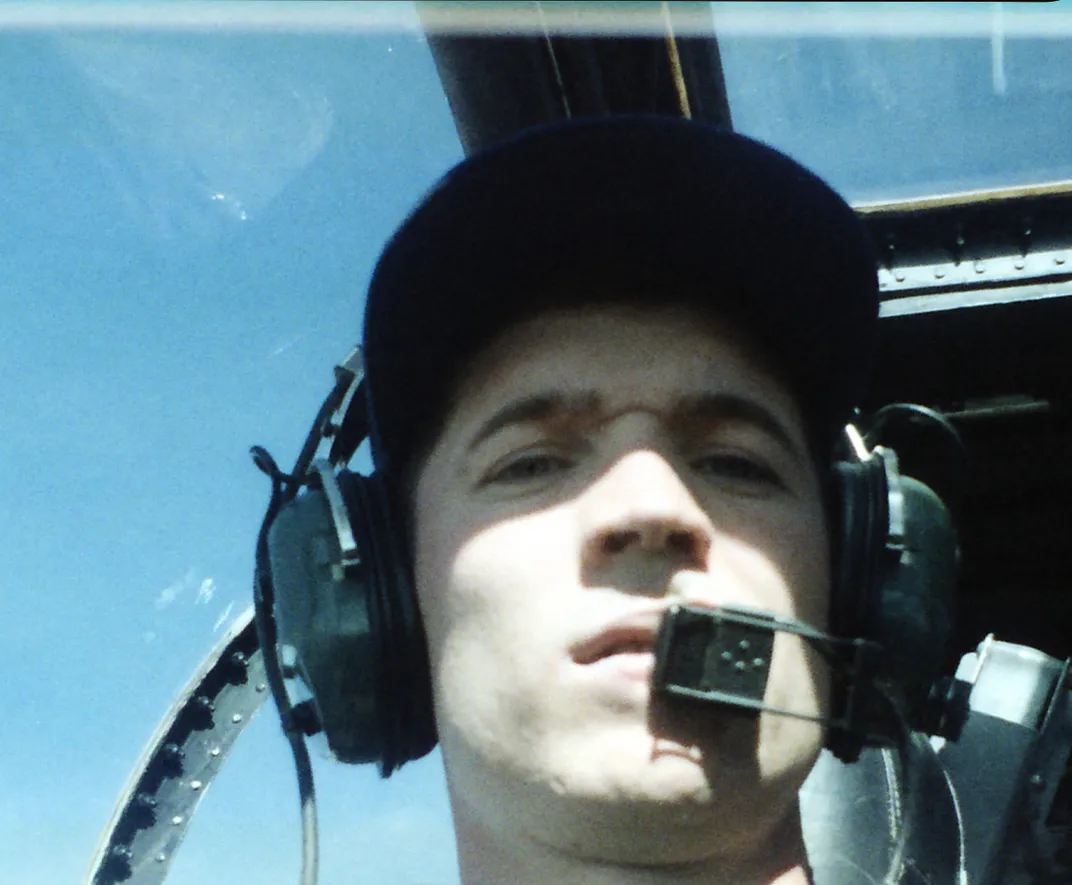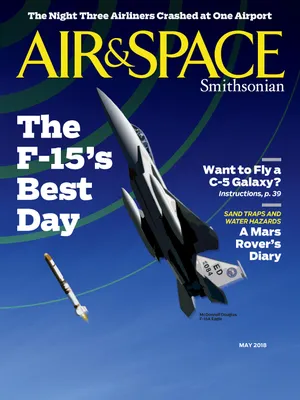My Week With Willie the Whale
Armed with a copy of the 1954 pilot handbook, I climbed into the F3D Skynight’s cockpit.
/https://tf-cmsv2-smithsonianmag-media.s3.amazonaws.com/filer/9c/69/9c6977b8-e6e5-4580-9690-eed851058ed9/17e_am2018_paul-blessphantom_live-2.jpg)
As an impressionable Marine first lieutenant reconnaissance officer assigned to squadron VMFP-3 at El Toro, California, in 1982, I worked in the back seat of a McDonnell RF-4B Phantom II. But I was captivated by the tales our chief warrant officers told me about their experiences inside the cockpit of the Douglas F3D (F-10) Skyknight during the Vietnam War. An unusually large fighter aircraft from the 1950s, its fat fuselage—featuring side-by-side seating for the two-man crew—earned the F3D the nickname Willie the Whale.
Something about the Whale appealed to me. In an era where swept wings and pointy noses got all the attention, it was admirably ugly. Throughout my flight training, I had kept an F3D photograph torn from an expired Westinghouse calendar tacked above my desk.
One afternoon, a CWO nicknamed Lizard mentioned that several Skyknights were still flying somewhere in New Mexico. A few phone calls later, I learned these Skyknights were being flown by the Raytheon Company out of Holloman Air Force Base, near Alamogordo. Holloman had been the site of many seminal aeronautic milestones—John Stapp’s 1954 rocket-sled speed record, Joseph Kittinger’s 1960 sky dive from 102,800 feet—bestowing an air of mystery that had lingered into the 1980s. (I’d even heard wild rumors that President Eisenhower had met with aliens there.)
I called Raytheon Flight Test, and Phil Middleton, Raytheon’s chief pilot, told me that Holloman operations included one RA-3B Skywarrior and the last two remaining F3D Skyknights. My enthusiasm for an unloved old airplane must have won him over: He told me that if I could get myself to Holloman, I could fly in one.
I was fortunate in that my squadron could spare me for a week at that time. So one leave request, one America West Airlines ticket to El Paso, and one rental car reservation later, I rolled up to the gate at Holloman.
I was given the 1954 edition of the Skyknight’s pilot handbook. Almost three decades old, it was the most recent reference available. I noted the half-inch thickness of the spine—one-sixth the page count of the manual for the Phantom I was accustomed to flying. I was struck by an illustration that demonstrated normal entry procedure for the Skyknight. The crew were wearing baseball caps, sunglasses, headsets, and backpack-style parachutes. No helmets, torso harnesses, or G-suits. They looked like they were leaving for a vacation, not a mission.
The following day, I followed Phil to the hangar. We opened the entrance hatch and then the escape chute, a feature particular to the Skyknight. Phil slid an old mattress beneath the fuselage. He then instructed me to man the right seat and slide down the chute. Two round trips later, I was pronounced “egress qualified” and ready for the next stage of my training.
The missions I’d be flying would be to employ electronic countermeasures and chaff dispensers against the Army’s Patriot missile system radar, which was then undergoing development at the nearby White Sands Missile Range. I surmised that the jamming pods mounted on the Skyknight were our best guess as to the Soviet capabilities of that era.

The Skyknights had been well preserved since their days in naval service: the carpet, windshield wiper, and cigarette lighter and ashtray (!) were all still intact. The maintenance crew had made a few smart modifications to reduce the hours of labor required for their upkeep. The wing spoilers, blamed for numerous hydraulic issues, had long ago been deactivated. The tailhooks had been removed, to Phil’s chagrin. The hard rubber tail-bumper wheel, intended to protect the aft fuselage from tail strikes due to over rotation on takeoff or angle-of-attack issues upon landing, had been replaced with a machined-steel facsimile that would have lasted over 100,000 miles of bad road. Lastly, the fuselage sides now sported “ARMY” service markings, reflecting the airplane’s support of the Army’s Patriot program. It was a harsh fate for an old Navy jet.
The Skyknight was designed before the era of single-point refueling: Each of the three fuselage tanks had to be filled individually. If the maintainers did not carefully balance the load as they hand-pumped the fuel, the tail-bumper would get some action. The Skyknight’s J-34 engines burned aviation gasoline and not the more familiar jet fuel.
The installation of the aircraft’s little J-34 engines in big nacelles designed for J-46 engines that never materialized made it necessary for Douglas to angle the tailpipes downward, creating a blowtorch effect. As a result, Skyknights wreaked fiery havoc on the wooden carrier flight decks of the 1950s as well as on asphalt. At Holloman, the twin exhausts of our Skyknights were aimed directly down toward the asphalt hold short area adjacent to the departure runway, and the heat actually melted the asphalt. Once the pilot was cleared for takeoff, coming up on the power to taxi blew away the gravel under the asphalt, leaving a twin tail of molten tar and potholes.
I soon found that all the stories I’d heard about the Whale were true. It was definitely underpowered; 6,800 pounds of thrust pushing 25,000 pounds of airframe left a lot to be desired. Flight operations at Holloman were usually conducted in the early morning before it got too hot. Even then, full internal fuel, a jamming pod under each wing, and 4,000 feet of field elevation made takeoffs dicey.
The high altitude and high temperature placed the Skyknight close to the edge of its performance limits. The takeoff roll could take every inch of the runway. It was standard procedure at Holloman to taxi into and use some of the 1,500 feet of available overrun during takeoff just to make sure old Willie got into the air before passing the runway’s departure end.
The Skyknight made up for its lack of power through its endurance. The pilots routinely gave the Patriot test directors 2.5 hours on station.
That gave us the opportunity to enjoy the view. Visual Flight Rules flying in a tactical jet was a rare treat for me. Flying “the world’s slowest jet,” we had no problem obeying the Federal Aviation Administration regulation prohibiting flight in excess of 288 miles per hour below 10,000 feet. We finished these excursions by jumping into the pattern at nearby Roswell Industrial Airport—“Roswell By the Sea,” Phil called it, reasoning that all that sand meant there had to be a beach nearby—for a few touch-and-gos before heading home.
Back at Holloman, we entered the traffic pattern and pulled our best 3-G break downwind. I reveled in reaching up and opening the overhead ditching hatch, the roar of the wind in my ears as I keyed the mike and reported four down and locked (couldn’t forget that tail-bumper) to the tower. Rolling out after touchdown, Phil would maintain a little back stick pressure to keep the nosewheel off the deck until old Willie was as slow as possible; otherwise you would receive a quick education in why it had a thing called a shimmy dampener. (It was a cylinder filled with fluid attached to the nosewheel to help keep it stable.) On deck taxiing to park, we always folded the wings to remind everyone that although the Skyknight was now landlocked and wore Army livery, it was a Navy bird at heart.
The base search-and-rescue unit shared the other half of the duplex hangar, and they were eager to know why a civilian and a Marine were flying a Navy jet with Army markings from an Air Force base. I’m sure they thought we were up to something strange. We took great pleasure in telling them, “Sorry. We can’t talk about it.”
